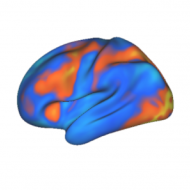.jpg) 20) Spike-timing dependent plasticity: Getting the brain from correlation to causation (Levy – 1983, Sakmann – 1994, Bi & Poo – 1998, Dan – 2002)
20) Spike-timing dependent plasticity: Getting the brain from correlation to causation (Levy – 1983, Sakmann – 1994, Bi & Poo – 1998, Dan – 2002)
Hebb's original proposal was worded as such: "When an axon of cell A is near enough to excite a cell B and repeatedly or persistently takes part in firing it, some growth process or metabolic change takes place in one or both cells such that A's efficiency, as one of the cells firing B, is increased." [emphasis added]
The phrase "takes part in firing" implies causation of B's activity via A's activity, not simply a correlation of the two.
There are several ways to go beyond correlation to infer causation. One method is to observe that one event (e.g., cell A's activity) comes just before the caused event (e.g., cell B's activity).
In 1983 Levy showed with hippocampal slices that electrically stimulating cell A to fire before cell B will cause long-lasting strengthening of the synapse from cell A to cell B. However, when the opposite occurs, and cell A is made to fire after cell B, there is depotentiation of the same synapse. In other words, timing is essential for synaptic learning. Today, this form of learning is called spike-timing dependent plasticity (STDP).
Using this rule, Levy has created a variety of neural network models aimed at understanding memory in the brain (e.g., especially in the hippocampus; see this paper for a short review).
More recently, other researchers including Sakmann, Bi, Poo, and Dan have further characterized this phenomenon. They showed that it occurs in vivo, within a specific time window (~8 msec timing difference is optimal), in neocortex, and (using behavioral evidence) in humans.
Figure caption: A) Figure from Bi & Poo (1998) showing the effects of STDP in potentiation and depotentiation with optimal results ~8-10ms in either direction. B) Figure from Markram et al. (1997) showing the timing of the stimulation relative to the post-synaptic cell's EPSP. C) Another figure from Markram et al. (1997) showing the resulting long-term changes in synaptic efficacy due to the manipulations in figure B.
Implication: The mind, largely governed by reward-seeking behavior on a continuum between controlled and automatic processing, is implemented in an electro-chemical organ with distributed and modular function consisting of excitatory and inhibitory neurons communicating via ion-induced action potentials over convergent and divergent synaptic connections strengthened by timing-dependent correlated activity. The cortex, a part of that organ organized via local competition and composed of functional column units whose spatial dedication determines representational resolution, is composed of many specialized regions involved in perception (e.g., touch: parietal, vision: occipital), action (e.g., frontal), and memory (e.g.,short-term: prefrontal, long-term: temporal),which depend on inter-regional communication for functional integration.
[This post is part of a series chronicling history's top brain computation insights (see the first of the series for a detailed description). See the history category archive to see all of the entries thus far.]
-MC & PL

Leave a comment